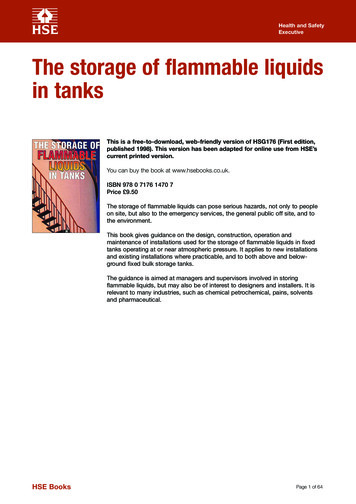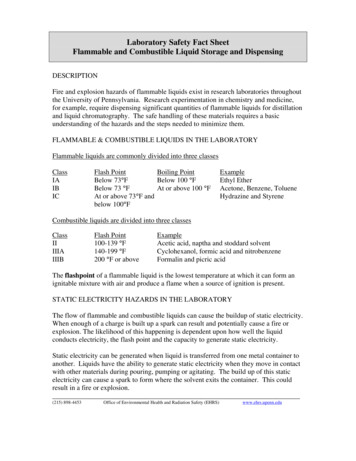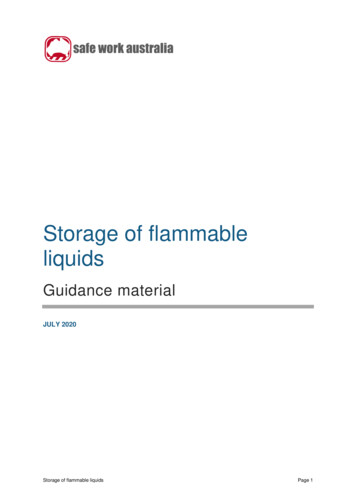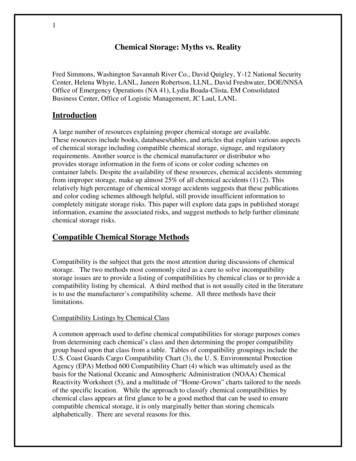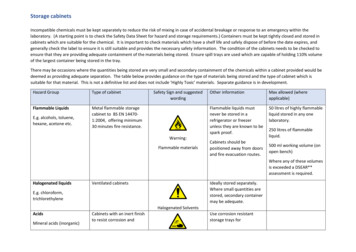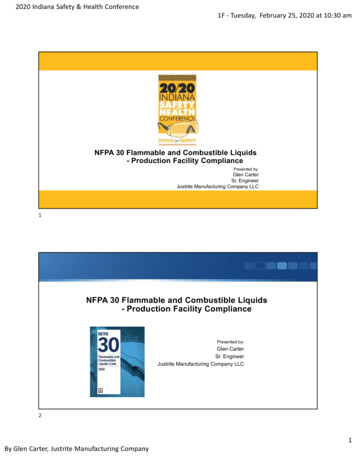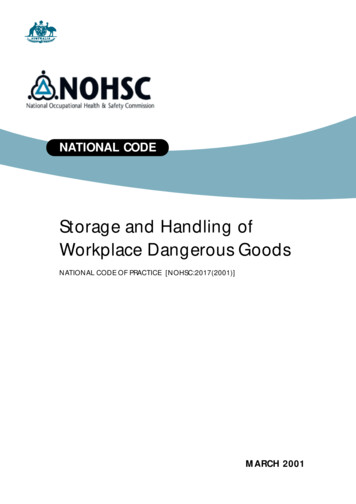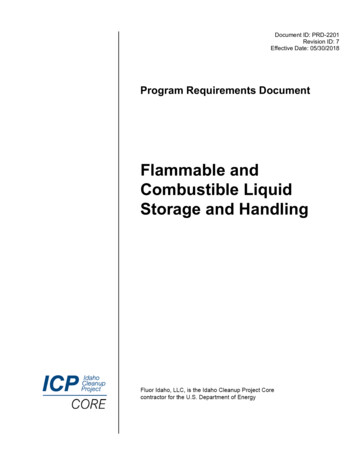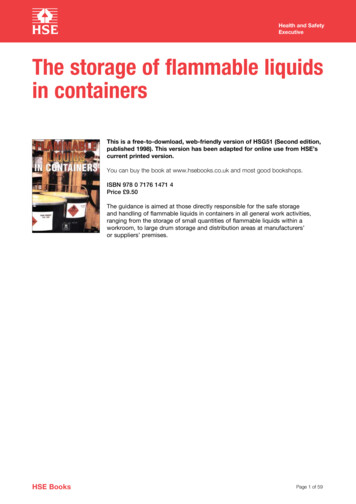
Transcription
Health and SafetyExecutiveThe storage of flammable liquidsin containersThis is a free-to-download, web-friendly version of HSG51 (Second edition,published 1998). This version has been adapted for online use from HSE’scurrent printed version.You can buy the book at www.hsebooks.co.uk and most good bookshops.ISBN 978 0 7176 1471 4Price 9.50The guidance is aimed at those directly responsible for the safe storageand handling of flammable liquids in containers in all general work activities,ranging from the storage of small quantities of flammable liquids within aworkroom, to large drum storage and distribution areas at manufacturers’or suppliers’ premises.HSE BooksPage 1 of 59
Health and SafetyExecutive Crown copyright 1998First published 1990Second edition 1998ISBN 978 0 7176 1471 4All rights reserved. No part of this publication may be reproduced, stored ina retrieval system, or transmitted in any form or by any means (electronic,mechanical, photocopying, recording or otherwise) without the prior writtenpermission of the copyright owner.Applications for reproduction should be made in writing to:The Office of Public Sector Information, Information Policy Team,Kew, Richmond, Surrey TW9 4DU or e-mail: licensing@opsi.gov.ukThis guidance is issued by the Health and Safety Executive. Following the guidanceis not compulsory and you are free to take other action. But if you do follow theguidance you will normally be doing enough to comply with the law. Health andsafety inspectors seek to secure compliance with the law and may refer to thisguidance as illustrating good practice.The storage of flammable liquids in containersPage 2 of 59
Health and SafetyExecutiveContentsPreface 4Objectives 5Introduction 6General 6Legal requirements 6Scope 7Hazards 9Main hazards 9Health hazards 10Safety precautions 11Introduction 11The VICES principles 14Ventilation 15Ignition 17Containment 19Exchange 22Separation 22Fire precautions and emergency procedures 30Fire precautions 30Emergency procedures 31Storage facilities 33Temporary storage 33Storage of small quantities 33Storage of finished products 34Storage and display at retail premises 34Storage of higher-flashpoint liquids 35Suggested storage facilities for a range of premises 36Appendices1Legal requirements 402Fire-resisting structures 473Hazardous area classification 49References and further reading 52Glossary 57The storage of flammable liquids in containersPage 3 of 59
Health and SafetyExecutivePrefaceThis book provides information on the fire and explosion hazards associated withthe storage of flammable liquids in containers. It sets out practical measures on thedesign, construction, operation and maintenance of storage areas, buildings androoms used for storing flammable liquids at normal (ie ambient) temperatures andpressures. It gives examples of storage facilities for a number of different types ofbusiness. These measures are designed to protect people at work and others whomay be affected by the storage of flammable liquids.The guidance is aimed at those directly responsible for the safe storage andhandling of flammable liquids in containers in all general work activities, rangingfrom the storage of small quantities of flammable liquids within a workroom, to largedrum storage and distribution areas at manufacturers’ or suppliers’ premises.Safety specialists and trade organisations or associations may wish to use thispublication as a basis for more specific guidance for their own members.While the references to British or other standards made in this book specifytheir year of issue, it is recognised that they are regularly updated and many areharmonised into a common European standard. Invariably, any such replacementstandards may be used in place of the standards quoted.The storage of flammable liquids in containersPage 4 of 59
Health and SafetyExecutiveObjectivesThe objectives for this publication are to:nnnnnhelp in the assessment of the risks from the storage of flammable liquidsin containers, and advise on how to control those risks;increase the awareness of the potential fire and explosion hazardsassociated with the storage of flammable liquids in containers;advise on safe management procedures and precautions to reduce injuriesand damage caused by fires and explosions during the storageof flammable liquids in containers;give guidance on the appropriate standards for the design andconstruction of storage areas, buildings and rooms used for storingflammable liquids at ambient temperature and pressure; andadvise on the need for appropriate fire precautions, maintenance,training and good housekeeping where flammable liquids are stored incontainers.The storage of flammable liquids in containersPage 5 of 59
Health and SafetyExecutiveIntroductionGeneral1This book provides you with guidance on the control measures you couldadopt for the safe storage of containers containing flammable liquids. It sets outthe steps you need to take to control the risks of fire and explosion, although somegeneral advice is given on health risks where this may be helpful.2The guidance applies to all storage locations whether in the open air, or inspecifically designed buildings, rooms or cabinets. It applies to new and existingsites.Legal requirements3This book will help in your assessment of the risks arising from the storageof flammable liquids in containers, and it gives advice on how to control the risks.Assessment, by employers and the self-employed, of the risks to employees andothers who may be affected by the work activities is one of the requirements of theManagement of Health and Safety at Work Regulations 19921.4This book also advises you on how to comply with the relevant parts of theHealth and Safety at Work etc Act 19742 at places where flammable liquids arestored and, where applicable, with the Highly Flammable Liquids and LiquefiedPetroleum Gases Regulations 19723 and other relevant legislation (see Appendix 1).5Current legislation, guidance literature and standards are referred to in thetext and are listed in the references section. They are subject to amendment fromtime to time. You need to ensure that the requirements, at the time any work oralterations are carried out, reflect the current legal requirements and good acceptedpractice. The glossary at the back of this book explains the particular terms used inthe text.What is risk assessment6A risk assessment is an organised look at your work activities using thefollowing five steps:Step 1:Step 2:Step 3:Step 4:Step 5:Look for the hazards.Decide who may be harmed and how.Evaluate the risks arising from the hazards and decide whetherexisting precautions are adequate or if more needs to be done.Record your significant findings.Review your assessment from time to time and revise it ifnecessary.Advice on carrying out risk assessments is contained in an HSE leaflet4.7The remaining sections of this book will help you to identify many of thehazards associated with the storage of flammable liquids in containers, and giveguidance on how you can reduce the risks.8The guidance shows many of the issues you need to consider when carryingout risk assessments. It will help in deciding which precautions are necessaryconcerning the storage arrangements for flammable liquids in containers.A complete risk assessment made under the Management of Health and SafetyThe storage of flammable liquids in containersPage 6 of 59
Health and SafetyExecutiveat Work Regulations 19921 will also have to consider other hazards, for examplemanual handling and transport safety, which are not within the scope of this book.ScopeDefinition of flammable liquid9In this book ‘flammable liquid’ generally means a liquid with a flashpoint of55 C or below.10nnThis definition includes:all liquids classified as flammable, highly flammable or extremelyflammable for supply according to the Chemicals (Hazard, Informationand Packaging for Supply) Regulations 1994 (as amended)5; andhighly flammable liquids as defined in the Highly Flammable Liquidsand Liquefied Petroleum Gases Regulations 19723.11 This definition does not include however liquids, with a flashpoint equal to ormore than 21 C and less than or equal to 55 C, which do not support combustionwhen tested at 55 C according to the method described in Schedule 2 of theHighly Flammable Liquids and Liquefied Petroleum Gases Regulations 19723.12 Some Regulations, particularly those concerned with the transport ofdangerous goods, define flammable liquids as those with a flashpoint of less thanor equal to 61 C. Although some of the liquids defined according to transportlegislation will be outside the scope of this book, it will nevertheless still be goodpractice to store them according to the recommendations given here.Applying the standards13 The advice in this book provides you with suitable standards for the designand location of storage facilities for flammable liquids in containers. It is applicableto flammable liquids contained in metal, glass and plastic receptacles, drums,barrels, tins, IBCs (Intermediate Bulk Containers) etc.14 It may be inappropriate or impractical for you to adopt all therecommendations in this book at existing premises. However the law requires youto make any improvements which are reasonably practicable, taking into accountthe risks at the premises and the cost and feasibility of additional precautions. Seethe Glossary for a definition of the term reasonably practicable at the back of thisbook.15 This book describes a number of ways of achieving an adequate standardof safety. Further advice on how to use it at specific sites can be obtained fromwhoever inspects the site for health and safety, usually HSE or the local authority.Environmental protection16 Spillages of flammable liquids can have environmental consequences and maybe subject to controls under the Environmental Protection Act 19906.17 Although this guidance does not attempt to cover environmental issues,the advice it contains for safe storage conditions will generally also provide someprotection for the environment. You can find information on the environmentalhazards posed by a particular flammable liquid in the specific substance materialsafety data sheet (MSDS) available from the supplier.The storage of flammable liquids in containersPage 7 of 59
Health and SafetyExecutive18 Further guidance is available from the Environment Agency (or in Scotland,the Scottish Environment Protection Agency (SEPA)) or from local authorities, whoenforce the 1990 Act6.Additional advice and information19 You can find more appropriate advice in documents listed in the Furtherreading section at the back of this book about:nnncarriage, loading and unloading, spraying and use of flammable liquids;dispensing and storage of petrol at filling stations; andspecific industries.20The advice in this book does not apply to the following flammable liquids:nthose which present special hazards requiring specific precautions, such as:–– ethylene oxide;–– peroxides;–– other liquids which carry a risk of rapid decomposition, polymerisation orspontaneous combustion;nnnthose contained in aerosols or other pressurised containers;liquefied petroleum gas;other substances which are gases at ambient temperature and pressurebut are stored as liquids under pressure.21 This book does not apply to containers with capacities of greater thanapproximately 1000 litres. For larger containers and those which are connecteddirectly to a process or other point of use, advice is contained in an HSEpublication7.Liquids with a flashpoint in the range 32 C to 55 C22 Some of the precautions and control measures are not appropriate for lowerhazard liquids with a flashpoint in the range 32 C to 55 C.23Advice on variations for these liquids is contained in paragraphs 171–183.24 Where no variation is shown for any aspect, the standards in the main textapply.Flammable liquids which are pesticides25 All pesticides are subject to Part III of the Food and Environment ProtectionAct 1985 (FEPA)8, and they must be approved either:nnunder the Control of Pesticides Regulations 19869 (as amended); orunder the Plant Protection Products Regulations 199510 (as amended) and thePlant Protection Products (Basic Conditions) Regulations 199711.The FEPA Part III Code of Practice12 and HSE Agriculture information sheet No 1613are available for guidance on the safe storage of pesticides.26 However, you may use this book for more detail on the precautions needed todeal with the flammable hazard of such pesticides.The storage of flammable liquids in containersPage 8 of 59
Health and SafetyExecutiveHazardsMain hazards27 The main hazards from the storage of flammable liquids are fire and explosion,involving either the liquid or the vapour given off from it. Fires or explosions arelikely to occur when liquid or vapour is released and comes into contact with asuitable ignition source, or alternatively, when a heat or fire source comes intocontact with the container.28Common causes or contributory factors of such incidents include:nnnnnnnnlack of awareness of the properties of flammable liquids;operator error, due to lack of training;inadequate or poor storage facilities;hot work on or close to flammable liquid containers;inadequate design, installation or maintenance of equipment;decanting flammable liquids in unsuitable storage areas;exposure to heat from a nearby fire;dismantling or disposing of containers containing flammable liquids.Combustion of liquids29 Combustion of liquids occurs when flammable vapours released from thesurface of the liquid ignite (see Figure 1).FuelFlammable gasesFlammable liquidsFlammable solidsGeneral combustible materialsOxygenAlways present in the airAdditional sources fromoxidising substancesIgnition sourceHot surfaceElectrical equipmentStatic electricitySmoking/naked flamesFigure 1 The fire triangleThe storage of flammable liquids in containersPage 9 of 59
Health and SafetyExecutive30 The extent of a fire or explosion hazard depends on the amount of flammablevapour given off from a liquid which is determined by:nnnnnthe temperature of the liquid;the volatility of the liquid;how much of the surface area is exposed;how long the liquid is exposed for; andthe air movement over the surface.31 Other physical properties of the liquid give additional information on howvapour/air mixtures may develop and also on the potential hazards. These physicalproperties include:nnnnnflashpoint;auto-ignition temperature;viscosity;lower explosion limit; andupper explosion limit.Flashpoint32 Flashpoint is defined as the lowest temperature at which a liquid gives offvapour in sufficient quantity to form a combustible mixture with air near the surfaceof the liquid under specified test conditions. Generally, a liquid with a flashpointbelow the ambient temperature of the surroundings will give off sufficient vapourto mix with the air and be ignited. Liquids with a flashpoint greater than ambienttemperature are less likely to give off a flammable concentration of vapour unlessthey are heated, mixed with low flashpoint materials or released under pressure asa mist or spray. The lower the flashpoint of a liquid, the higher the risk.Viscosity33 The viscosity of the liquid is also significant as it determines how far any spiltmaterial will spread and therefore the size of any exposed surface.Health hazards34 Flammable liquids can pose a health hazard if they are ingested, come intocontact with skin or eyes, or their vapours are inhaled. For example, methanolis toxic as well as flammable. Information on the health hazards of a particularliquid, and on any specific precautions required, should be obtained from thematerial safety data sheet (MSDS) or from the supplier. The Control of SubstancesHazardous to Health Regulations 199414 require employers to assess the healthrisks from exposure to hazardous substances and the precautions needed.Paragraphs 37–39 give further details on health precautions.The storage of flammable liquids in containersPage 10 of 59
Health and SafetyExecutiveSafety precautionsIntroduction35 Although this book describes ways in which you can achieve an adequatestandard of safety, variations from these may be appropriate to meet localconditions. You may use therefore alternative designs, materials and methodswhere your risk assessment shows that they provide an equivalent or higher overalllevel of safety.36 The precautions outlined do not take into account possible damage from anexternal source such as a major incident that affects a wide area.Health precautions37 Many precautions for reducing fire and explosion risks will also control thehealth risks. But some additional measures may be necessary since concentrationsof vapours, capable of damaging human health, are usually significantly below theflammable levels.38 The Control of Substances Hazardous to Health Regulations 199414 requireemployers to prevent or control exposure to harmful substances. Guidance onthese Regulations is contained in the Approved Codes of Practice (ACOPs) entitledGeneral COSHH ACOP, Carcinogens ACOP and Biological Agents ACOP: Controlof Substances Hazardous to Health Regulations 199415.39 An obvious precaution to take against skin and eye contact is to provide itemssuch as gloves, protective clothing and goggles. Suitable respiratory protection maybe needed during any operations to deal with leaks and spillages.Marking and labelling40 Individual containers must be clearly marked to indicate their contents and thedegree of flammability. In most cases this will be required by the Chemicals (HazardInformation and Packaging for Supply) Regulations 19945 (as amended) (CHIP) andthe Carriage of Dangerous Goods (Classification, Packaging and Labelling) andUse of Transportable Pressure Receptacle Regulations 199616 (CDG(CPL)). Certainanomalies may exist with regard to the labelling of liquids with flashpoints in therange 56–61 C. For these liquids, flammability labelling is not required under CHIP,but is required under the CDG(CPL) Regulations16.41 The Health and Safety (Safety Signs and Signals) Regulations 199617 requirestores and areas containing significant quantities (greater than 25 tonnes) ofdangerous substances to be identified by appropriate warning signs.42 The majority of sites on which 25 tonnes or more of dangerous substancesare stored must be marked in accordance with the Dangerous Substances(Notification and Marking of Sites) Regulations 199018.43 Storerooms, cupboards and bins need to be marked to indicate the hazardsassociated with their contents. The yellow hazard triangle symbols (see Figure 2),which are widely available, indicate the flammability hazards clearly. If it is notreasonably practicable to mark directly on the storage area, then it can bedisplayed nearby. ‘No smoking’ and ‘No naked lights’ notices may be appropriate.Maintenance and modifications44 Many incidents involving flammable liquids occur during maintenance andrepairs.The storage of flammable liquids in containersPage 11 of 59
Health and SafetyExecutive45 The likelihood is increased if the work is done by staff or outside contractorswho have little knowledge of the hazards associated with flammable liquids. Youshould only employ experienced contractors. A guide is available which givessound practical advice for selecting and managing contractors19.FLAMMABLE LIQUIDFigure 2 Hazard triangle symbol46 The Health and Safety at Work etc Act 19742 and the Management ofHealth and Safety at Work Regulations 19921 place duties to ensure safe workingpractices on both the company using the services and the contractor.47nnnnIt is essential that no maintenance work is done until:the potential hazards of the work have been clearly identified and assessed;the precautions needed have been specified in detail;the necessary safety equipment has been provided; andadequate and clear instruction has been given to all those concerned.48 In most cases, a permit-to-work (PTW) system should be used to controlmaintenance operations20 in areas where flammable liquids are stored or used.PTWs are formal management documents (see Figure 3). They should only beissued by those with clearly assigned authority to do so, and the requirementsstated in them must be complied with before the permit is issued and the workcovered by it is undertaken. Individual PTWs need to relate to clearly definedindividual pieces of work. PTWs should normally include:nnnnnnn49the location and nature of the work intended;identification of the hazards, including the residual hazards and thoseintroduced by the work itself;the precautions necessary, for example, isolations;the personal protective equipment required;the proposed time and duration of the work;the limits of time for which the permit is valid; andthe person in direct control of the work.Further advice on PTWs is available in an HSE leaflet21.50 There are some simple controls you can adopt to reduce the risks of fire andexplosion during maintenance hot work. You need to make sure that all flammableor combustible materials are removed from the work area. If it is not reasonablypracticable to remove such materials, then you could position suitable screensor partitions to protect the hazardous inventory. Once the work has finished, youneed to thoroughly inspect the area for at least an hour to ensure that there is nosmouldering material present.The storage of flammable liquids in containersPage 12 of 59
Health and SafetyExecutive11 Permittitle233 Job location44 Plant identification566 Hazard identification - including residualhazards andhazards introduced by the work77 Precautions necessary - person(s) whocarries out precautions, eg isolations, shouldsign that precautions have been taken2 Permit number.Reference to other relevantpermits or isolationcertificates5 Description ofwork to be doneand its limitations88 Protective equipment99 Authorisation- signature confirmingthat isolations have been made and10precautionstaken,except where thesecan only betaken during the work.11Date andtime duration of permit1210 Acceptance signature confirmingunderstanding of workto be done, hazardsinvolved and precautionsrequired. Also confirmingpermit information hasbeen explained to allworkers involved11 Extension/shifthandover12 Hand back - signed byprocedures -signaturesconfirming checks made 13acceptor certifying workcompleted. Signed bythat plantremains safe to beissuer certifying work completedworked upon, and new acceptor/workers madefully aware ofand plant ready for testinghazards/precautions. New time expiry givenand recommissioning13 Cancellation certifying work tested andplant satisfactorilyrecommissioned(Signatures – names must be legible)Permits save lives – give them proper attentionFigure 3 PTWInformation and training51 Adequate training and knowledge of the properties of flammable liquids areessential for their safe storage.52 Training is a requirement of the Management of Health and Safety at WorkRegulations 19921. Carrying out risk assessments required by these Regulationswill identify how much information, training and retraining are needed. Furtherguidance on these Regulations is contained in an Approved Code of Practice22.53 You need to inform all staff on the site about the hazards of storing flammableliquids, and about the need to exclude sources of ignition and heat from thedesignated storage areas. Those responsible for the operation of the store alsoneed to receive specific training in how to deal with spillages and leaks, andemergency procedures.54 Periodic retraining will normally be required. The training should include thefollowing aspects:nthe types of flammable liquid stored, their properties and hazards;The storage of flammable liquids in containersPage 13 of 59
Health and SafetyExecutivennnnngeneral procedures for safe handling;use of protective clothing;housekeeping;reporting of faults and incidents, including minor leaks and spills; andemergency procedures, including raising the alarm, calling the firebrigade and the use of appropriate fire-fighting equipment.You will need written procedures for controlling the risks from the storage offlammable liquids, and these should be used as the basis for training.The VICES principles55 There are five general principles for ensuring that the risks of fire andexplosion, from the storage of flammable liquids in containers, are controlled andminimised. An aid to remembering these five principles is the acronym ‘VICES’.There is no order of priority of the principles implied by the use of the acronym.VVentilationIs there plenty of fresh air where containers are stored? Good ventilationmeans vapours given off from a spill, leak, or release, will be rapidly dispersed.IIgnitionHave all ignition sources been removed from the storage area?Ignition sources can vary widely. They include sparks from electricalequipment or welding and cutting tools, hot surfaces, smoking, andopen flames from heating equipment.CContainmentAre your flammable liquids stored in suitable containers? Will a spillagebe contained and prevented from spreading to other parts of the storagearea or site? A means of controlling spillage would be the use of animpervious sill or low bund. An alternative is to drain the area to a safeplace, such as a remote sump or a separator.EExchangeCan you exchange a flammable liquid for a less flammable one?This is a basic question you should always ask. Can you eliminatethe storage of flammable liquids from your operation altogether?SSeparationAre flammable liquids stored well away from other processes andgeneral storage areas? Can they be separated by a physical barrier,wall or partition?56 The remainder of this publication covers detailed control measures, essentiallybased on the ‘VICES’ principles.The storage of flammable liquids in containersPage 14 of 59
Health and SafetyExecutiveVentilationIntroduction57 To prevent dangerous concentrations of flammable vapours building up ina store or storage area as the result of a leak, the space needs to be adequatelyventilated.58 Containers should, where reasonably practicable, be stored in the open air atground level (singly or in stacks). This enables leaks or releases to be quickly seen,and allows for any vapours to be dispersed effectively by natural ventilation.They should not normally be stored on the roof of a building but if, for reasons ofspace, the use of rooftop storage is considered essential, the enforcing authorityand the fire authority need to be consulted.59 If the best option of storing containers outside is not reasonably practicable,they may be kept in suitable storerooms, preferably separate buildings specificallydesigned for the purpose.Ventilation within buildings60 You need a good standard of ventilation in buildings or rooms used for storingflammable liquids, to disperse the vapours from any small releases. The ventilationarrangements need to take into account the heavy nature of the vapours, and toensure adequate air movement at high and low levels.WinddirectionFigure 4 Roof and wall vents together give good natural ventilation61 Five air changes per hour is normally sufficient to ensure vapour levels in thestore are kept to a low level. For small buildings, the simplest method of ensuringadequate ventilation is to provide fixed, permanent openings (such as air bricks orlouvers etc) at high and low levels in external walls to the outside air. The five airchanges per hour may be achieved if these openings have a total area equivalentto 1–3% of the total area of the walls and roof of the store. The actual area requireddepends on whether the building is in exposed or sheltered weather conditions.BS 5925: 199123 gives advice on ventilation principles and designing for naturalventilation in buildings.The storage of flammable liquids in containersPage 15 of 59
Health and SafetyExecutive62 In cases of doubt, measurements may be taken of the air change rate actuallyachieved in a completed building. A competent ventilation engineer should be ableto do this.63 If openings are present on two walls, a cross-flow induced by wind forcesis encouraged. Vents provided at high and low level will encourage air circulationby thermal currents (see Figure 4). Remember not to position ventilation openingsin internal walls, or below the level of any containment sill provided. The openingsshould not be obstructed on either side by, for example, container stacks, dirt orrubbish.64 Ventilation openings should not normally be installed in any partitionsdesigned to be fire-resisting (see Appendix 2). Where this is unavoidable, suchopenings will be required to self-close in a fire situation so as to provide separation.You should seek the advice of competent fire engineers if this option is considered.Providing mechanical ventilation65 If the provision of natural ventilation is not possible, because, for example, thestoreroom is located centrally within a large workroom, then adequate ventilationcan be provided by mechanical means. Larger buildings, stores with only oneor two outside walls, or buildings in sheltered locations are also likely to requiremechanical ventilation.66 Where this is provided it needs to operate constantly. Failure of an extractionsystem can be detected by an airflow monitoring device installed in the ductwork(such as a flow switch or differential pressure switch) and linked to an alarm.67 Remember that the exhausted air needs to be routed to a safe place in theopen air, via fire-resisting ductwork (see Appendix 2). Ducts should be arrangedso that vapours cannot condense and collect at low points within the ductwork. Inmost cases it should be adequate if the ventilation ductwork is terminated:nnnat least 3 metres above ground level;at least 3 metres from building openings, boundaries, sources of ignition;andaway from building eaves and other obstructions.Requirements for positioning
The storage of flammable liquids in containers. This is a free-to-download, web-friendly version of HSG51 (Second edition, published 1998). This version has been adapted for online use from HSE's . Definition of flammable liquid. 9 In this book 'flammable liquid' generally means a liquid with a flashpoint of 55 C or below.
